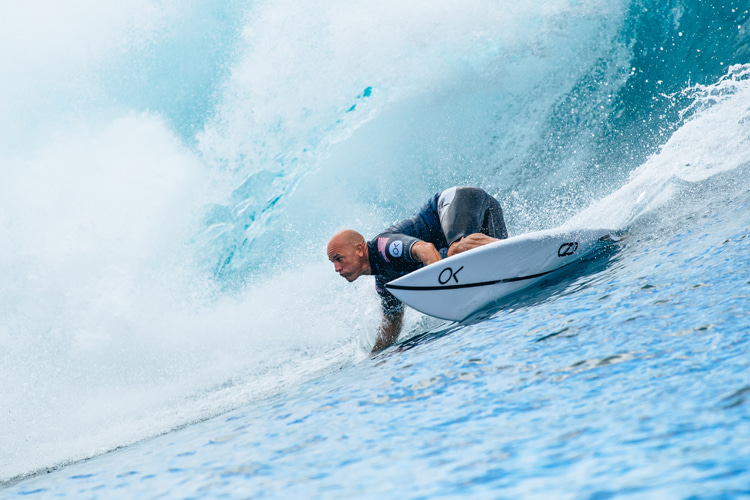Why are hip replacement surgeries so common in surfers?

Hip replacement surgeries are relatively common among surfers, and it’s easy to understand why.
A surfer’s body is constantly pivoting and absorbing impacts.
On top of that, the surfer’s regular or goofy stance generates uneven and unbalanced pivoting, for instance, when cutting back or carving.
Therefore, professional surfers and highly-active recreational surfers experience repeated stress and trauma to the hip joint.
Last but not least, surfing in challenging conditions for several years and decades can lead to various injuries and wear and tear on the hips.
Kelly Slater, Laird Hamilton, and Griffin Colapinto are some of the few examples of different-generation athletes who had to undergo surgery to replace a hip.
But what exactly causes excessive wear and tear to the hip region, especially among the wave-riding community?

Causes of Damaged Joints
Some reasons why hip replacement surgeries are more prevalent among surfers include:
Repetitive Stress and Sudden Movements
Surfers often perform repetitive motions, such as paddling, popping up on the board, and making quick turns.
These behaviors can place significant stress on the hip joint over time, contributing to the development of issues.
Also, after quick and dynamic movements, surfers may sometimes find themselves in awkward positions or make sudden movements that can strain the region, leading to injuries.
High-Impact Landings
Surfing, especially in larger waves, involves high-impact landings and maneuvers.
Surfers may land forcefully on the water, and this impact can lead to injuries or accelerated wear of the hip joint, including damage to the labrum and cartilage.
Underlying Structural Factors
Some individuals may have underlying structural issues with their hip joints, such as abnormal shapes or alignment, making them more prone to injuries and wear and tear.
Age and Career Duration
Older surfers or those with long surfing careers may experience a cumulative effect of wear on their joints.
The longer someone has been actively surfing, the more likely they are to develop hip issues over time.
Environmental Factors
The type of waves and conditions in certain surf spots can contribute to the stress on the hips.
For example, powerful waves, point breaks, and pounding beach breaks may increase the risk of lesions.

Kelly Slater’s Hip Replacement
Kelly Slater is one of the many surfers who had to undergo hip replacement surgery.
“The first time I ever injured my hip, I was 19. I was trying to figure out how to surf Sunset Beach,” Slater explained after the surgical intervention.
“I was trying to hit the lip to a floater, and I got pitched out. So, I probably fell like 10 or 12 feet. I tried to stick it, and when I hit, my back foot came off.”
“I did the splits, and the lip landed on me, and I actually thought I broke my femur – that was the feeling. I’m like, ‘Oh, the legs broken up there.'”
“So I’m underwater just getting absolutely drilled, trying to hold my leg, and then I came up, and I was just like, ‘what the heck just happened?'”
“That was the first time I hurt my labrum. And then I did it about two or three more times in my 20s.”
“One time, I was towing with Kalama in Tahiti, and we were just like trying to do flips off waves, and I tried to land one at the back, but I was like trying to err on the side of falling, so I kind of took my back foot a little out of the strap, and I split again from eight feet high.
“I just was too above the board. I should have been more on my butt. So I came from doing the splits a few times.”
“I had surgery on my hip in the summer of 2000, labral cleanup, and just a basic arthroscopic, and I was basically back in the water in about a month and a half.”
“This one’s gonna be like three to four months.”
“So this surgery was much more sensitive, and they have better techniques now, 23 years later.”
“So I had a complete labral reconstruction where they took a cadaver labrum and inserted it and tied it into my bone.”
“I had bone fragments, like four big bone fragments in the joint, that were like embedding into the labrum and tearing it, and I had some other foreign bodies – I don’t know what those were that had to get taken out.”
“Warren Kramer said that my labrum was basically shredded from end to end except for a small section about an inch long.”
“And then I had bone spurs on the femur head. They had to clean up and shave and then the socket joint; they also had to shave and clean up as well. So, pretty extensive.”
“What happens with some people is when they’re young if they’re if your hips a certain shape it can bang up against the socket, the femur does, and then the socket will start to grow bone just to stop that from happening, and then you lose range of motion, and you get stiff, and then you start like ruining your cartilage.”
“The body’s smart, so it’s trying to stop that movement. I also had a lot of scar tissue cut out. Warren got in there and said it looked like a war zone.”
“He said before he could get in, he had to chop through the woods and cut a bunch of scar tissue out, so there was a lot of stuff going on.”
“It would explain why I don’t want to surf a lot because my hip hurts so much. I’m in pain a lot. It’s also affecting my back radically because I’m constantly having to try to get to a position like I internally rotate and pull my hip back, and then that throws my back off.”
“I actually have pretty extensive scoliosis, but it’s functional.”
“I think because my hips are kind of level, so my legs aren’t really like different lengths, but I’ve been able to let that functional pattern work with my muscle somehow and figure out where I need to be.”

Surfing after Post-Hip Replacement Surgery
Surfing after a hip replacement is always possible.
However, it depends on various factors, including the type of surgery performed, the individual’s overall health, and their dedication to rehabilitation.
While many people can return to surfing after a hip replacement, there may be some impact on their surfing ability.
The replaced hip may not have the same range of motion as a natural hip, and individuals might need time to adapt to the changes.
Here are some considerations regarding surfing after hip replacement surgery:
Recovery Period
The initial recovery period after hip replacement surgery typically involves restrictions on certain activities, including those involving high impact or excessive hip twisting.
Following the surgeon’s recommendations and adopting physical therapy to regain strength and mobility is crucial.
You should count on at least one and a half months of rest and recovery.
Surgeon’s Clearance
Individuals should seek clearance from their orthopedic surgeon before returning to surfing or any physically demanding activity.
The surgeon will assess the recovery’s progress, the stability of the hip joint, and the individual’s overall readiness to resume sporting activities.
Individual Variability
People vary in their recovery timelines and the extent to which they can resume sports like surfing.
Factors such as age, overall fitness, adherence to rehabilitation, and the success of the surgery play a role in determining when and how one can return to surfing.
Modified Surfing Techniques
Even after recovery, some individuals may need to modify their surfing techniques to reduce stress on the replaced hip.
It might involve adjusting their stance, avoiding certain maneuvers, or being cautious about the impact when paddling or popping up on the board.
Self-Monitoring
It’s essential for individuals with a hip replacement to pay attention to their bodies and avoid pushing themselves too hard.
Any pain, discomfort, or limitations should be communicated to healthcare professionals, and adjustments may be necessary.



